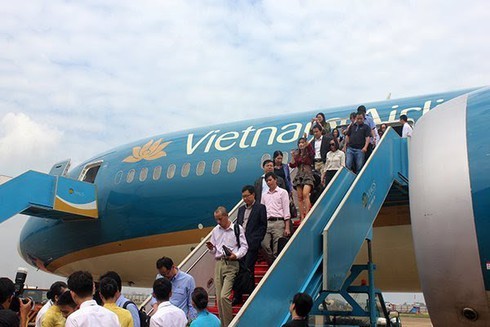 |
The Vietnamese aviation regulator offered its insights into the Vietnamese aviation transportation market, especially in terms of the future needs for aircraft purchases among airlines, as part of a report to the Ministry of Transport regarding Thien Minh Aviation JSC’s proposal to set up a new airline, called Kite Air.
The report noted that between 2014 and 2018, the local aviation market saw average growth rates of 20.5% in passengers and 13.2% in cargo.
Some 70 million passenger arrivals and 1.2 million tons of cargo went through the country’s airports last year, up 12.6% and 7.2%, respectively from one year earlier. Also, local airlines had an average seat occupancy rate of more than 84%.
The regulator cited a government decision which approves zoning adjustments to develop the aviation sector, saying that local airlines will carry more than 60 million passengers by 2020 and nearly 96 million five years later.
Therefore, the airlines are expected to be operating 255 aircraft by 2020 and 384 by 2025. The forecast figures are based upon the average annual transport capacity of 250,000 passengers per plane among local airlines.
The CAAV has made specific recommendations on the number of airplanes which each airline should operate.
For example, the national flag carrier Vietnam Airlines and its subsidiary, Vietnam Air Services Company (VASCO), should have a fleet of 107 aircraft next year, and 135 by 2025.
The respective figures for low-cost carrier Jetstar Pacific are 22 and 32, while those for fledgling airline Bamboo Airways are 22 and 30.
The budget airline Vietjet is also planning to raise the number of its planes to 102 next year and 200 by 2025.
CAAV General Director Dinh Viet Thang said in the report that these airlines would have a total of 397 planes by 2025, with 13 planes exceeding the forecast demand. That is not to mention fleets of aircraft owned by Vinpearl Air, Vietravel and Kite Air that have yet to start operation now.
CAAV especially called upon Vietjet to take the number of its planes into account, to ensure the fleet is in alignment with the carrier’s operational and management capacity, flight network and workforce in charge of the fleet.
The regulator advises the carrier to raise its fleet at fewer than 10 aircraft each year. As such, its fleet should include 84 planes next year and 120 by 2025, up 46 planes compared with its current fleet. SGT
 The Civil Aviation Authority of Vietnam (CAAV) has advised local airlines to refrain from adding significant numbers of new aircraft, noting that their fleets could far exceed passenger and cargo transportation needs.
The Civil Aviation Authority of Vietnam (CAAV) has advised local airlines to refrain from adding significant numbers of new aircraft, noting that their fleets could far exceed passenger and cargo transportation needs.